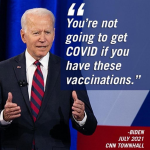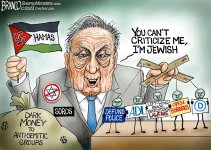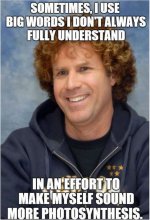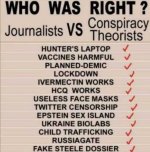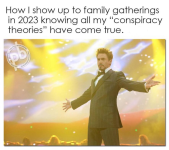For anyone not completely understanding what "propaganda" really is, here is a refresher course. Remember, there are actually liberal democrat mouth breathers who drank this all in as gospel.

Heck, most of them probably still do.
Falsehoods and debunked narratives MSNBC promoted
The Russia collusion hoax
Much of the Trump presidency was plagued by the Russia collusion narrative that ultimately withered on the vine. Stemming from allegations peddled behind the scenes by the Hillary Clinton campaign in 2016, the narrative that the Trump campaign coordinated with the Kremlin to win the election snowballed into a years-long investigation by Special Counsel Robert Mueller, whose report concluded there was no evidence of a conspiracy.
The Hunter Biden laptop is ‘Russian disinformation’
Like the vast majority of legacy news organizations, MSNBC was quick to dismiss the bombshell revelations of Hunter Biden's laptop during the 2020 election as "Russian disinformation."
"Morning Joe" co-host Joe Scarborough declared the story "false" and later claimed it was "so obviously" Russian disinformation, asking, "Why are we spreading the lies here?"
Co-host Mika Brzezinski cited multiple reports about intelligence agencies investigating Rudy Giuliani's dealings with "alleged Russian agents," as well as whether emails from Hunter Biden's laptop are "linked to a foreign intel operation."
Nicolle Wallace was more confident in dismissing Hunter Biden's laptop, telling viewers, "We shouldn't look at it as anything other than a Russian disinformation operation." MSNBC anchor Katy Tur mocked the Post's story, saying it "dropped like a bomb," but to "wither under scrutiny, not really dropping like a bomb."
Jussie Smollett's 'hate crime' hoax
MSNBC jumped on the bandwagon in automatically believing disgraced actor Jussie Smollett, who staged his own hate crime in the dead of night during Chicago's historic polar vortex in January 2019. He alleged that two Trump supporters donning red Make America Great Again hats assaulted him and hurled racist and homophobic slurs at the "Empire" star shouting "This is MAGA country!"
It was later revealed that he had hired two Nigerian brothers to orchestrate the attack. Smollett was convicted of disorderly conduct in 2021.
But when Smollett first came forward with the hoax, an emotional Ruhle called it a "horrible story."
"It gets worse," Ruhle told viewers at the time. "One of the offenders wrapped a rope around Smollett's neck."
The smearing of Covington teen Nicholas Sandmann
Another hoax from 2019 involved the smear campaign leveled at a group of students from Kentucky's Covington Catholic High School who had visited Washington D.C. for the annual March for Life.
A video had gone viral showing one "MAGA" hat-wearing student, Nicholas Sandmann, smiling at Native American elder Nathan Phillips beating a drum and singing a chant as he was surrounded by Sandmann's peers, who all had joined in on the chant in front of the steps of the Lincoln Memorial.
However, several media outlets, including NBC, portrayed the incident with Sandmann and the other teens as being racially charged before it was discovered by additional footage that a group of Black Hebrew Israelites had provoked the confrontation by slinging racial slurs at the students as they were waiting for their bus. Footage then showed Phillips, who was in town for the Indigenous Peoples March, approaching the students amid the rising tension between the two groups.
On the weekend edition of "NBC Nightly News," NBC News' José Díaz-Balart called it a "troubling scene many are calling racist."
"Some students harassing an older Native American, of yet a Vietnam vet in the midst of a special ceremony," Díaz-Balart told viewers. Later in the report, NBC News correspondent Tammy Leitner said, "Tonight some wondering how this peaceful rally became a sad display of disrespect."
Relentless attacks against Kyle Rittenhouse
During the 2020 unrest in Kenosha, Wis., following the police-involved shooting of Jacob Blake, 17-year-old Kyle Rittenhouse fatally shot two people and injured a third person while acting in self-defense. He was later found not guilty following a dramatic trial that received national attention.
But despite what a jury concluded, MSNBC found him guilty right from the beginning.
MSNBC contributor Jason Johnson compared Rittenhouse to a "school shooter."
‘whipping’ of Haitian migrants at the border
One of the biggest controversies of 2021 was the false narrative that Border Patrol agents were "whipping" Haitian migrants at the southern border.
Images had gone viral of horseback border agents in Del Rio, Texas, showing them using what critics had thought were "whips" to attack Haitians attempting to enter the U.S. when in reality law enforcement was only equipped with reins to control their horses.
While the false narrative was even accepted early on by the Biden administration, several MSNBC personalities also took turns magnifying it, including "All In" host Chris Hayes, who shared the images peddling the "whip" claims online.
On MSNBC, NBC News correspondent Yamiche Alcindor accused the border agents of "using reins against migrants, citing critics of the Biden administration who say it "looks like slavery" and call the treatment "cruel" and "inhumane."
But the biggest promoter of the narrative was Joy Reid. "This is beyond repulsive. Are these images from 2021 or 1851??" Reid posted online in reaction to the images.
MSNBC stars pushed out Ronna McDaniel from their "sacred airwaves," which has featured such narratives as Trump-Russia collusion and Hunter Biden's laptop being disinformation.

www.foxnews.com

 www.americansecurityproject.org
www.americansecurityproject.org










